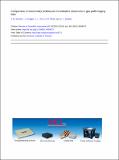Comparison of velocimetry techniques for turbulent structures in gas-puff imaging data
Author(s)
Cziegler, I.; Zweben, S. J.; Sierchio, Jennifer M.; Terry, James L; White, Anne E.
DownloadAnne White Sierchio - RSI 87 2 2016.pdf (11.36Mb)
PUBLISHER_POLICY
Publisher Policy
Article is made available in accordance with the publisher's policy and may be subject to US copyright law. Please refer to the publisher's site for terms of use.
Terms of use
Metadata
Show full item recordAbstract
Recent analysis of Gas Puff Imaging (GPI) data from Alcator C-Mod found blob velocities with a modified tracking time delay estimation (TDE). These results disagree with velocity analysis performed using direct Fourier methods. In this paper, the two analysis methods are compared. The implementations of these methods are explained, and direct comparisons using the same GPI data sets are presented to highlight the discrepancies in measured velocities. In order to understand the discrepancies, we present a code that generates synthetic sequences of images that mimic features of the experimental GPI images, with user-specified input values for structure (blob) size and velocity. This allows quantitative comparison of the TDE and Fourier analysis methods, which reveals their strengths and weaknesses. We found that the methods agree for structures of any size as long as all structures move at the same velocity and disagree when there is significant nonlinear dispersion or when structures appear to move in opposite directions. Direct Fourier methods used to extract poloidal velocities give incorrect results when there is a significant radial velocity component and are subject to the barber pole effect. Tracking TDE techniques give incorrect velocity measurements when there are features moving at significantly different speeds or in different directions within the same field of view. Finally, we discuss the limitations and appropriate use of each of methods and applications to the relationship between blob size and velocity.
Date issued
2016-02Department
Massachusetts Institute of Technology. Department of Nuclear Science and Engineering; Massachusetts Institute of Technology. Department of Physics; Massachusetts Institute of Technology. Plasma Science and Fusion CenterJournal
Review of Scientific Instruments
Publisher
American Institute of Physics (AIP)
Citation
Sierchio, J. M.; Cziegler, I.; Terry, J. L.; White, A. E. and Zweben, S. J. “Comparison of Velocimetry Techniques for Turbulent Structures in Gas-Puff Imaging Data.” Review of Scientific Instruments 87, no. 2 (February 2016): 023502. © 2016 American Institute of Physics (AIP)
Version: Final published version
ISSN
0034-6748
1089-7623